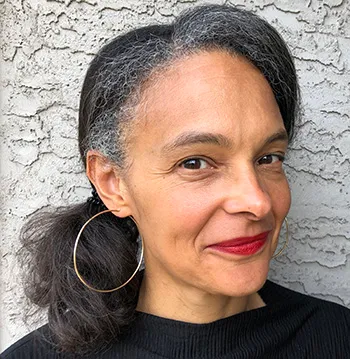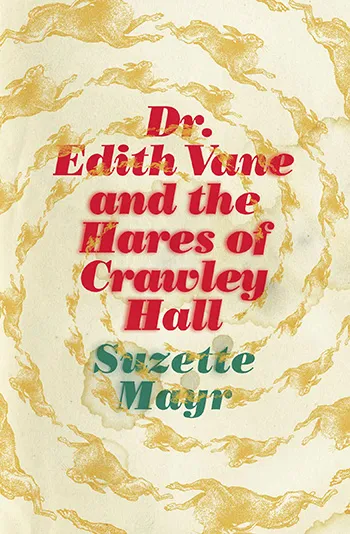
Horror can be anywhere, but usually in a haunted house, an abandoned building, or a graveyard. However, for author and professor Suzette Mayr, nothing seemed more unsettling than a university.
Sick buildings
"I wanted to write a horror. I wanted to write about a haunted building," she said, recalling the early inspiration for her novel Dr. Edith Vane and the Hares of Crawley Hall. "I started noticing that there's a particular kind of haunted house, and that's the sentient house.
"Like in The Haunting of Hill House by Shirley Jackson, where it's not just a building with a bunch of ghosts in it, but the building itself is kind of contaminated and evil. And corresponding to that was the whole idea of sick buildings. You have these buildings where it's just clusters of illnesses
"...On my university campus, the University of Calgary, there's a building called Craggy Hall, where a lot of people were getting breast cancer, and nobody could explain it."
The occurrences at Craggy Hall were not uncommon. Old buildings often have materials, like lead paint, that can cause illnesses, like cancer, in people who spend a lot of time in them. This topic fascinated Dr. Mayr.
"In Australia, there's the Australian Broadcasting Corporation Building," she continued. "It was a building that had 16 [women got breast cancer] in a span of a short time... They tried to do tests on the building, but they could not figure it out. By the end, when the 17th woman got breast cancer, they evacuated the building. It was an odd and scary phenomenon."
With the idea of the "sick building" stewing in the back of her mind, Dr. Mayr also decided to explore her surroundings. "I've been interested in campus satire, so I thought, 'I'm just going to write from my own experience as an academic.'"
Eventually, she ended up with the character of Dr. Edith Vane, who is not necessarily Dr. Mayr but does share some similarities. "Edith Vane, the main character, is not me,." she said. "She's sort of, like, if in my career I turned right where she turned left. If I went down these stairs, she went up the stairs. So, she's sort of like an id, kind of a very Dorian Gray reflection of my career and my own experiences."

Writing her identity into the character
Writing Dr. Edith Vane was therapeutic, in a way, for Dr. Mayr. The character allowed her to explore her feelings about her career and relationship with the institution of higher education. "I wanted to investigate the notion of failure and imposter syndrome and the mechanics of postsecondary institutions that systemically favor certain groups over others. It was an institution made for white, straight men with wives. The rest of us who don't fit into that, we've got different challenges. It was my kind of investigating that."
To use the story of Dr. Vane to investigate the complexities of the institution, Dr. Mayr felt that incorporating her identities into the story was a must. "I knew that Edith Vane was going to be a Queer person. That was non-negotiable," she said. "I couldn't imagine it any other way, partly because of my own experience. Also, because I think for Queer people, postsecondary institutions, on one hand, can be incredibly welcoming, but at the same time, you can have those moments of feeling 'other.'
"It just struck me that having a Queer character was appropriate for writing about an uncanny building because, as Queer people, we are often outside looking in. Or... we have a perspective that is different from the dominant culture, from mainstream heterosexual culture," she continued.
Portraying Dr. Vane's sexuality positively was very important for Dr. Mayr. "I wanted her to have sex, too. I wanted her to have joyous sex. Because the main character has such a miserable life, I wanted, at the very least, for her to have a good sex life."
Reexamining the campus
Reexamining the institutions she was a part of through her novel also helped Dr. Mayr understand how certain subtleties in her environment impacted her mental health. "There was a bad point in my career where I was just really hating my job," she said. "It was sort of like I was getting all these microaggressions, just little racist moments where I was like, 'I don't even know what was happening.' It was just registering that they were so often and small and frequent.
"There was this one day when I was at the photocopy machine... and all of a sudden, [it] breaks down, and my first thought was, 'This machine's racist,' and I was like, 'Okay, there's something wrong with me, something is happening to me.'"
"So, that's where the book came from," she continued. "It was me taking my experience as an academic, and making it uncanny. Making it horrific. I know that the book is not a horror in the conventional sense, but there have been academics who have read the book and felt bad after reading it, because it emphasizes just all the nonsense that can happen when you work as a professor. So that makes me happy, because that was what I wanted to do."
The outside coming in
The book rests in the uncanny valley, hovering between reality and a slightly twisted version. "When I think of the uncanny, I'm thinking of Freud's sense of the uncanny, which is taking something, whether it's an experience or an object, or a place where you live or you work, and skewing it a little bit off. It's not a big jump-scare," Dr. Mayr said.
Although the horror of Dr. Edith Vane is less gory and more subtle, like a microaggression, it still packs a punch. Aside from the inspiration Dr. Mayr found in her real life, she also took tips from some of her favorite scary movies. "I love that movie The Ring. I love the main villain, the problematic ghost. She's got her hair in front of her face, but what I love about that is it's as though you're looking at somebody from the front, but their head is on backward. It's something as subtle as that.
"... In the academic context, there are numerous moments that are just absurd that I kind of pushed," she explained. "I work in the humanities. We tend to have buildings that are falling apart, because they're not as important as science, technology, medicine, business, etc. So, there was this one day when a pipe burst. There was a waterfall in the middle of the hallway, so we kind of [had] this exterior become interior."
She decided to run with the idea of the exterior becoming interior. After looking around, she discovered there were other outside elements that, once placed inside, became quite uncanny. "On my campus..., we have a lot of jackrabbits. When people read the book, and they're not from here, they think of rabbits as domestic bunnies. But the jackrabbits are the size of small dogs, maybe bigger? ...And when you drive past them at the night, their eyes glow red. So, part of my strategy for creating the uncanny was to set the book in a ...university building called Crawly Hall, and to have the outside gradually insinuate itself inside."
Writing her truth
Dr. Mayr says she will "absolutely" continue to write LGBTQ+ characters in her future projects. "I can't think of doing it any other way, and when I start a project, and I think, 'I need to write something different' and write a straight character, it just doesn't do it for me. I can't get into the character. I can't. It doesn't resonate for me. So that's what I'll always write about from now on, for sure, and I have for the last few books.
"Venus Hum, my third book, was sort of my coming-out book when I was figuring out, 'Okay, who am I? What am I doing? Who do I love?' And that book was me being like, 'I'm a Queer person, I love women.' I'm now in my fifties, and I can't even remember what it's like to sleep with men anymore. I would have to do a lot of research, which I don't feel like doing," she said laughing.
Writing Queer characters is second nature to her now. "For me, it's just about telling the truth," she said. "Be authentic, but also be aware that there are certain narratives out there that have been around, that have preceded us, that you maybe don't want to be playing into, like the whole 'kill your Gays' narrative, the 'dead Queer' somehow being romantic or interesting, or having Queer people as your built-in villain, and the villainy comes from them being read as deviant somehow. I think that's problematic. ...It's been done. It's boring. Stop it. What I try to do is write my truth."
Writing her truth also means writing about Black characters. "Black people are part of my reality, and so they will always feature in my books," Dr. Mayr said.
While her next book is a celebration of Black Queer joy, Dr. Mayr says Dr. Edith Vane has a different takeaway. "I hope people come away from the book thinking about themselves and thinking about self-care and what they need to do to stay healthy, mentally. I think that's probably part of it."
What's next
Dr. Mayr's next book will be coming out this fall, with a pending US release date of late September or early October. "It's called The Sleeping Car Porter," she said. "It's a historical fiction set in 1929, and it's about a sleeping car porter on a luxury passenger train that travels across the country. The... porter is a closeted Queer man. The best way to think of it would be that it's the story of this... porter taking a trip for three days and encountering all the characters on that train, but also confronting his sexuality, confronting his history, in terms of his intimate partners. There's a little bit of supernatural in there as well, because I love that so much."
"It's got a happy ending," she added reassuringly. "I find often that with, you know, stories with Black people, often there's this kind of fetish for pain and trauma and tragedy, and I don't want to contribute to Black pain. I want to write about Black joy, so this is a very joyous book, as far as the ending goes."
Fall frights
When it comes to Dr. Mayr's recipe for mental health, she says she finds joy in the autumn season and can't wait for temperatures to get crisp. "I love Halloween, so much," she said. "I buy a pumpkin and put it on our front step, and then it freezes overnight, and I need to go out and buy another. I love pumpkins. I love them. I love the smell of them. I love carving them. I love getting ready for Halloween. I love all the decorations that have to do with Halloween and then preparing... in any way possible. And then on Halloween night, staying home and watching a scary movie."
For those wondering what scary movies a horror writer watches – not the scariest! "I have movies that are scary that I'll never watch again, because I can't handle it. That would be, like, The Ring. It's a classic, and I cannot watch that movie ever again. Same with The Shining. But I do love the old version of The Haunting of Hill House, the movie that came out in the '60s. ....I think it's pretty cool. I do like some Hitchcock now and again, too."
If you're looking for an uncanny fall read that will make you think, pick up a copy of Dr. Edith Vane and the Hares of Crawley Hall at your local bookstore, and be on the lookout for The Sleeping Car Porter, coming soon.

